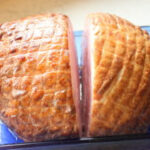Here in Utah, we cherish our state holiday, Pioneer Day, which falls near the end of July. This day is a celebration of the arrival of the first non-native settlers in Utah back in 1847. I have a captivating story to share about a pioneer quilt, crafted by some of these earliest settlers to my state, which was remarkably cut in two. Fortunately, both halves have survived, each telling a part of the story of the women who created it, including one woman who holds particular interest for me.
But before diving into that tale, let me share a brief anecdote about other ancestral quilts…
Pioneer Quilts and Personal Connections
I’ve always felt a special connection to Pioneer Day. It’s not just the bonus day off, the BBQs, the fireworks, and the family time, although those are certainly perks. It’s also because many of my ancestors were among those resilient pioneers who ventured across the continent into uncharted territories.
 A young girl in pioneer clothing works on a quilt block on a porch, embodying the spirit of volunteering as a recreation pioneer.
A young girl in pioneer clothing works on a quilt block on a porch, embodying the spirit of volunteering as a recreation pioneer.
About a decade ago, I recounted my summer as a Pioneer when my children and I volunteered at the Heritage Park Deseret Village in Salt Lake City. This living history museum recreates mid-19th century western settlements, and we had an incredible time immersing ourselves in that era. Despite the effort it took to participate at the time, I am eternally grateful for those shared memories with my kids – especially now that they are all grown up!
A few years later, during a fall break trip to the Grand Canyon, we made a detour to Snowflake, Arizona, on our way home. This town is another place where my ancestors settled later in the 19th century. Their home still stands there as a museum, and it was there that I discovered several quilts crafted by three generations of my foremothers. This included quilts made by my great-grandmother, whom I had the privilege of meeting as a toddler before she passed away.
While I’m sure many of my female ancestors created quilts (likely more out of necessity than purely as a creative outlet, though I hope it was a blend of both), I don’t possess any of these heirloom quilts myself, nor do I have much knowledge of their specific creations. Therefore, stumbling upon those quilts in Arizona felt like uncovering a genuine treasure!
Now, let’s shift our focus to the particularly fascinating pioneer-era story of the quilt that was divided in two.
The Story of a Pioneer Quilt Cut in Half and Pieced Back Together Again
This story is deeply connected to my Grandma, who passed away a few years ago. It feels like the perfect moment to share and preserve this piece of Pioneer Quilt History.
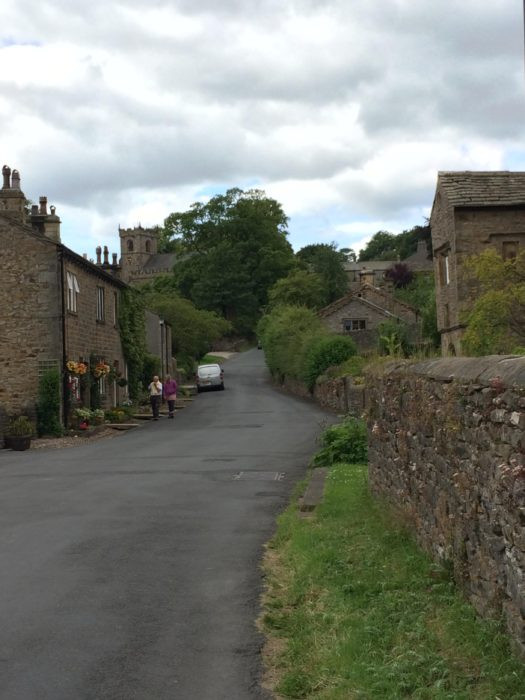 A picturesque street scene in Downham, Lancashire, England, the birthplace of a pioneer quilter.
A picturesque street scene in Downham, Lancashire, England, the birthplace of a pioneer quilter.
Twenty-seven years ago, I was nearing the end of my mission service for my Church in northern England. My parents journeyed to England to meet me and explore the places and people that had become dear to me during my time there before I returned home. One village I was particularly eager to show them was Downham, a charming little place nestled in the Ribble River valley of Lancashire.
My Dad had brought along some genealogical information about our English ancestors. The night before our visit to Downham, I made an exciting discovery: I had a Great-Great-Great Grandmother, Ellen Douglas Parker, who was born right in Downham! It suddenly made perfect sense why I had felt such an immediate connection to this place! Let me introduce you to Ellen.
Fast forward about ten years: I was married, raising young children, and working at my local quilt shop. One day, a customer started telling me about a book she was reading. It was about an Album Quilt made in Salt Lake City in 1857, a decade after the initial settlers arrived in the Salt Lake Valley. The author, Carol Holindrake Nielsen, explained that her husband had inherited half of this Album Quilt (yes, it had been cut in half!). This unusual inheritance was the starting point of a fascinating quest.
In 2004, after some dedicated research to locate distant relatives, the two halves of the quilt were finally reunited. Carol Nielsen expressed her feeling that “the posterity of the women who sewed the quilt must see the needlework of their ancestral mothers…” and recognized the importance of sharing the story of this quilt and its creators.
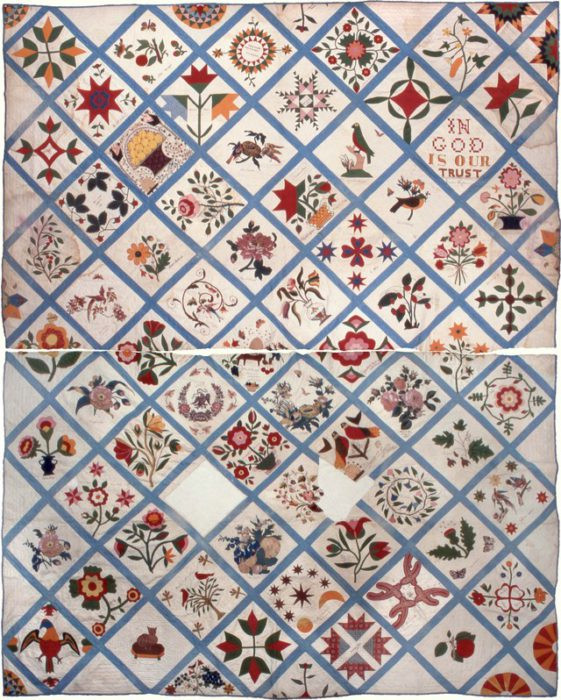 A meticulously hand-stitched block quilt, a testament to pioneer women's artistry and community spirit. Image source
A meticulously hand-stitched block quilt, a testament to pioneer women's artistry and community spirit. Image source
The blocks composing this quilt were created individually by members of the women’s Relief Society organization as a fundraising endeavor. The quilt showcases a remarkable range of quilting skill levels – from simple and straightforward blocks to others that are incredibly ornate and complex. Because each block was signed, in the traditional album quilt style of the era, the author was able to trace each woman who contributed to the quilt and recount their individual stories, bringing to life a rich tapestry of pioneer quilt history.
Isn’t it intriguing how some of the blocks were trimmed down to create the side-setting blocks? (I can’t help but wonder about the original makers’ reactions to that decision…)
As fate would have it (or perhaps fortunately?), the raffle was won by a 12-year-old boy, which I find rather amusing. (Having raised a couple of boys who were once twelve, I can’t quite picture them being overly thrilled about winning a quilt.)
However, this young winner ensured the quilt was well cared for, as his mother was one of the quilt makers, which likely played a part. Later in his life, rather than deciding which of his two daughters should inherit the quilt, he made the decisive choice to cut the quilt in half.
Luckily, both daughters cherished their respective halves of this pioneer quilt, passing them down through generations.
Intrigued by this captivating introduction and being a lover of pioneers, history, quilts, and antiques, I knew I had to read the book. I thoroughly enjoyed learning about the diverse women who contributed to the quilt. And as I continued reading, imagine my surprise when I discovered one of the contributors was none other than my own ancestor:
Ellen Parker!
It was such a delightful discovery to learn that this foremother of mine was also a talented quilter! I doubt I would have ever known otherwise, as I am not aware of any surviving quilts made by her.
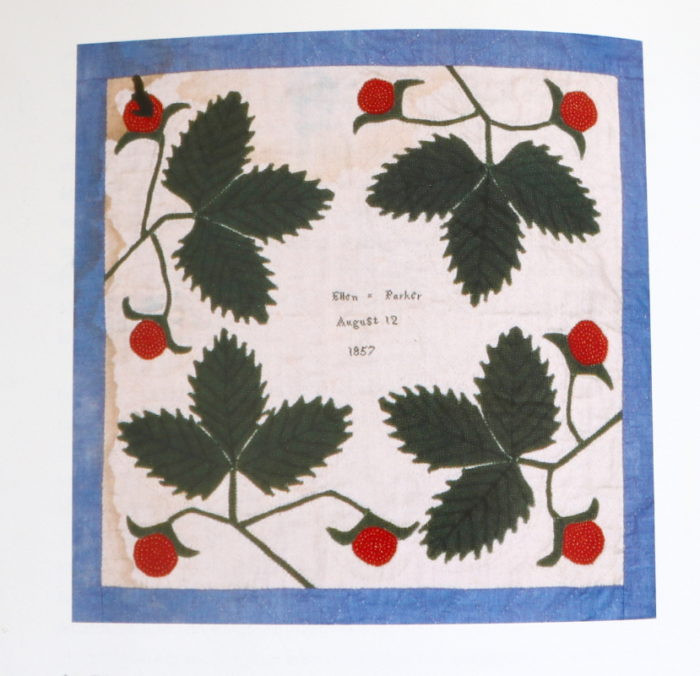 An antique quilt block featuring meticulously hand-stitched strawberries, crafted by Ellen Parker, a pioneer quilter of remarkable skill.
An antique quilt block featuring meticulously hand-stitched strawberries, crafted by Ellen Parker, a pioneer quilter of remarkable skill.
I also learned that Ellen was no ordinary quilter. Her block, in particular, is recognized as one of the most exquisite in the entire quilt. How did I come to know this? Shortly after reading the book, my mother heard that the author was giving a lecture and would be bringing her half of the quilt with her! So, I took my grandmother, the great-great-granddaughter of Ellen, to attend the lecture and see the quilt firsthand. Fortunately, Ellen’s block was part of the half of the quilt that the author had in her possession, allowing us to admire her handiwork up close.
And it absolutely blew my mind.
Honestly, I have never encountered applique quite like it! I truly wish I had a good photograph of that block to share. It was the most delicate, intricate applique I have ever witnessed, especially the strawberry stems and the tiny yellow stitches that formed the strawberry seeds. I deeply regret not taking a picture, but alas, this was in the pre-smartphone era, long before I had even conceived of starting a blog to share such images.
My grandmother also deeply appreciated this tangible connection to her past. It was at that moment that I decided it would be a wonderful project to somehow recreate that quilt block. Knowing that there was virtually no chance I could replicate that intricate needle-turn applique technique, I opted to create my reproduction block using wool felt. (I love wool applique – the raw edges are forgiving, and it’s so much easier to manipulate). I appliqued the wool onto a background of woven raw silk, which provides a beautiful texture and a homespun aesthetic. Then, I created this wall hanging as a Christmas gift for her in 2005.
After my Grandma’s passing a few years ago, I brought this wall hanging back to my home. It’s been comforting to have it with me again, especially because it serves as a reminder not only of my great-great-great-grandmother Ellen Douglas but also of my own grandmother, with whom I grew up.
Considering her exceptional skills, I am certain Ellen created many quilts throughout her lifetime. However, I am unaware of any others that have survived. Nor am I aware of quilts made by the majority of my other female ancestors. Therefore, I am incredibly grateful, not only that this block has survived and that I had the opportunity to see it in person, but also to 12-year-old Richard Horne for preserving the quilt through generations and to Carol Holindrake Nielsen for recognizing the importance and providing the means for the descendants of one of the women who sewed the quilt to “see the needlework of [her] ancestral mother…” This story truly underscores the enduring legacy of pioneer quilt history.
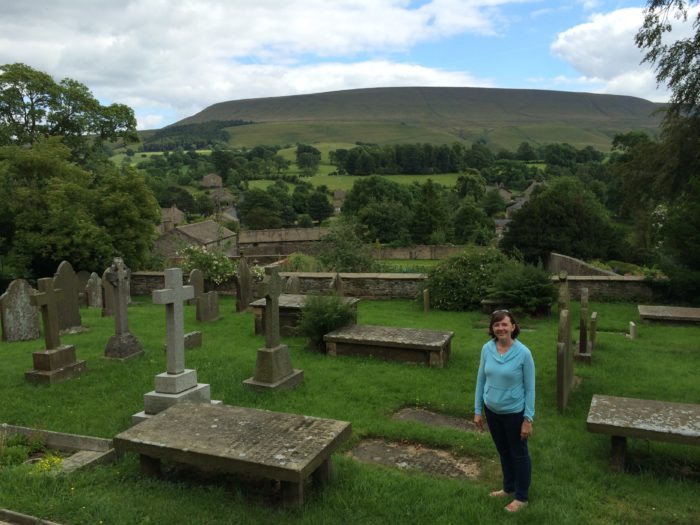 A woman stands in a peaceful cemetery in Downham, England, revisiting the roots of her pioneer heritage in 2014. Visiting Downham again in 2014
A woman stands in a peaceful cemetery in Downham, England, revisiting the roots of her pioneer heritage in 2014. Visiting Downham again in 2014
Ellen Parker’s Journey West: Continuing the Pioneer Story
A postscript about Ellen: Ellen emigrated to the United States in the 1840s. In the 1850s, she joined the Pioneer Migration westward to Utah with members of the Church of Jesus Christ of Latter-day Saints. By 1860, she and her husband were asked to help establish a new settlement named Virgin, along the Virgin River, near what is now Zion National Park in southern Utah. Having visited Ellen’s birthplace, I felt a strong desire to find her final resting place in the town where she lived for the last 20+ years of her life.
Visiting Virgin, Utah in 2016
One fall break, on our return trip from Zion National Park, we made a stop so I could locate Ellen’s grave in the Virgin City Cemetery. The contrast between the cemeteries of Downham, England, and Virgin, Utah, is striking and vast. (Personally, I think I prefer the tranquility of Downham.)
I am deeply grateful for these resilient foremothers who pioneered challenging territories. Some of these landscapes still appear quite desolate, in my opinion. Nevertheless, I am proud to believe I have inherited a sliver of their quilting talents, and I hope I’ve also inherited a portion of their tough, pioneer spirit.
Do you have ancestors who were quilters or special quilts woven into your family story? I would love to hear about them. Please share in the comments below!

